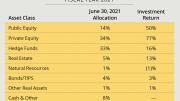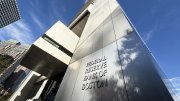The good news is that “Harvard’s finances ended the year in a dramatically improved position” compared to expectations during the pandemic, resulting in an operating surplus of $283 million for the fiscal year ended June 30, 2021, according to the annual financial report released on October 14. The great news is that the endowment soared in value to $53.2 billion—up from $41.9 billion a year earlier, driven by a 33.6 percent investment return on endowment assets—and so has finally made up the loss in purchasing power incurred in 2009, during the financial crisis and ensuing Great Recession. Distributions from the endowment are by far the University’s largest source of operating revenue: a pandemic-distorted 39 percent in fiscal 2021 (when tuition and fees were sharply depressed), up from 35 percent in 2019, so the gains loom large for the future.
2021: What Went Right
For the second year in a row, revenue decreased, to slightly less than $5.2 billion—but the total decline from fiscal 2019 was only about 5 percent (half as much as feared), as the pandemic affected the last part of 2020 and all of the most recent year. Unsurprisingly, total student income—tuition, room, board, and fees—decreased nearly $200 million (17 percent) in 2021, as hundreds of admitted undergraduates deferred their admission and hundreds more upperclassmen and -women took leaves, and most of the rest took their remote classes far from Cambridge. The restrictions on international travel curbed graduate and professional enrollment. With essentially everyone in degree programs back on campus now, student cohorts are historically large, so the revenue losses should largely reverse in the current year.
Net executive and continuing education revenue declined, too, to $378 million in fiscal 2021 from $410 million in the prior year. But that was a positive surprise: the contraction followed an 18 percent decline in fiscal 2020. The good performance reflects schools’ pivot to online offerings, and customers’ interest in maximizing their skills during the pandemic. On the other hand, this was a rapidly growing, $500-million business in fiscal 2019, on target to yield revenue of perhaps $600 million in fiscal 2021, until the coronavirus intervened. So the gap versus earlier expectations looms large.
Support for sponsored research grew modestly, again better than expectations, and donors came through: the endowment distribution (from past philanthropy) ticked up about 2 percent, to just more than $2 billion, and current-use giving surged $63 million (to $541 million, up 13 percent). Publication and royalty income was up meaningfully, too.
Expenses decreased more than $400 million (nearly 8 percent), to just under $5 billion. Part of that is bookkeeping. In fiscal 2020, the University recorded charges, probably totaling more than $230 million, for a retirement incentive program and an adjustment to the value of the below-grade construction for the Allston science and engineering complex; there were no similar charges in the most recent year.
Nonetheless, actual expenses declined, driven by the 1 percent reduction in compensation costs (more than half of annual expenses), reflecting those retirements, a nonunion salary freeze, and reduced hiring. The rest of the savings were pandemic-related: absent travel, and with buildings not fully occupied (lowering operating and utility bills), those costs and spending on supplies and miscellaneous services shrank by $175 million. Pandemic costs (testing and tracing, protective equipment, reconfiguration of buildings, technology for remote academic work) came to $83 million. Obviously, in the current academic year, both the expense reductions associated with largely remote operation in fiscal 2021, and the large coronavirus costs, should diminish significantly, perhaps resulting in a wash in the fiscal 2022 accounts.
On balance, Harvard’s internal belt-tightening, combined with external constraints (the impossibility of traveling on University business, for example), yielded operating surpluses of more than a half-billion dollars during the pandemic fiscal years (excluding those 2020 charges), even as revenues declined successively from $5.5 billion to $5.4 billion to $5.2 billion. None of this is normal: no one wants Harvard to operate in the black by choking off academic travel, in-residence education, or suppressing salaries and wages. But the University has come through a period when it anticipated potentially enormous losses with its finances, if anything, considerably strengthened.
The Endowment
Large as it was, the operating result paled in comparison to the enormous endowment gains. In the wake of multi-trillion-dollar pandemic measures adopted in Washington, D.C.—emergency relief appropriations under the Trump and Biden administrations, and sweeping interest-rate reductions from the Federal Reserve Board—financial markets responded with glee. U.S. stock market indexes gained 40-plus percentage points during the fiscal year ended June 30, prompting expectations for robust endowment returns, with estimated median gains of 33 percent: up tenfold from the prior fiscal year.
Expectations met. It was an historic time to own equity-oriented assets: stocks, private equity, and especially venture-capital investments. As the chart shows, Harvard Management Company (HMC), which oversees the endowment investments, reported a 77 percent return (after fees and expenses) on private-equity holdings, including venture capital: about one-third of the portfolio. Public equities returned 50 percent. The endowment corpus (including gift pledges, in Harvard’s accounting), $41.9 billion as of July 1, 2020, appreciated $12.8 billion in realized and unrealized gains. Subtracting the $2.0 billion distributed in fiscal 2021, and adding $500 million in gifts received, produces the fiscal 2021 year-end value of $53.2 billion: a one-year gain of $11.3 billion (27 percent). Given the University’s reliance on distributions from the endowment (and schools like the Faculty of Arts and Sciences’ even greater dependence: 54 percent of fiscal 2021 revenue), growth in the endowment’s value is the single most important factor in Harvard’s future financial health.
That may explain why the HMC report prompted some further thinking. Compared to the results of some schools with smaller endowments (University of Virginia, 49 percent, Brown 51.5 percent, Dartmouth 46.5 percent, Duke 56 percent), why did HMC earn “only” 33.6 percent on its portfolio? The question amplified when larger peers, with very diversified assets and a taste for illiquid, private ones, like Harvard, reported astonishing returns: MIT, 55.5 percent, Princeton, 46.9 percent, Stanford, 40.1 percent, Yale, 40.2 percent.
There is a simple answer. During the sweeping restructuring of HMC led by CEO N. P. Narvekar during the past four years (changes in structure, strategy, personnel, investment disciplines), its client, the University, has maintained the relatively cautious stance toward investment risk that it adopted following the catastrophic endowment losses in 2008-2009 and the economies that have largely been in place since. The large HMC allocations to hedge funds (one-third of assets) and cash, bonds, and inflation-protected securities all balance the risk of higher equity exposure and the il- liquidity associated with private-equity and venture-capital assets. Given the returns HMC’s investment partners produced during fiscal 2021, a University allocation that weighted private and public equity more heavily would have translated into aggregate gains more like those of Harvard’s closest peers.
HMC and the University have been discussing Harvard’s tolerance for investment risk during the past two years, and the Corporation was expected this fall to determine whether it wishes to retain the current exposure, or—perhaps now that the endowment has recaptured its purchasing power from a dozen years ago—authorize HMC to assume more risk in the expectation of greater long-term returns. Many factors will come into play: Harvard’s buildings are more spruced-up than they were at the beginning of the millennium, so there is less deferred maintenance; the pension funds are more adequately funded; rating agencies are more comfortable with the financial management (including the amount of cash kept on hand), and so the University retains its triple-A credit ratings and significant borrowing capacity. On the other hand, the reliance on the endowment has crept up (although it remains much lower, as a share of revenue, than at Princeton or Yale); and as Narvekar has pursued greater private-equity exposure, the unfunded commitments to external managers for future investments on HMC’s behalf have grown, too, to $12.5 billion at the end of fiscal 2021, up from $10.8 billion the prior year (with more than half for those illiquid private-equity funds). And of course the Corporation will have to weigh all that against its vision of Harvard’s future academic ambitions and investments.
Whatever decision the Corporation makes (a choice it may not make public), fiscal 2021 was one for the record books: Harvard survived the coronavirus with its human capital largely intact, and its financial resources enormously strengthened.
In his letter introducing the financial report, President Lawrence S. Bacow rightly points to the University’s investments in maintaining community members’ health, sustaining employment even of idled and contract workers, and, looking beyond “[t]hese necessary efforts directed inward” to the “extraordinary efforts directed outward.” Among these, he lists “working on the frontlines and saving lives in the ever-shifting landscapes of medicine and science, contributing to vaccination development and deployment, devising ways for learning and working to continue despite disruption, and addressing the profound racial, economic, and social inequities laid bare by the pandemic.”
Remarkably, as he observes, Harvard emerges—thanks to “strong financial stewardship” (and the other-worldly endowment results)—“positioned…to accelerate progress” on these and other issues.
For a complete report on the financial and endowment results, see harvardmag.com/endowment-surplus-21.









